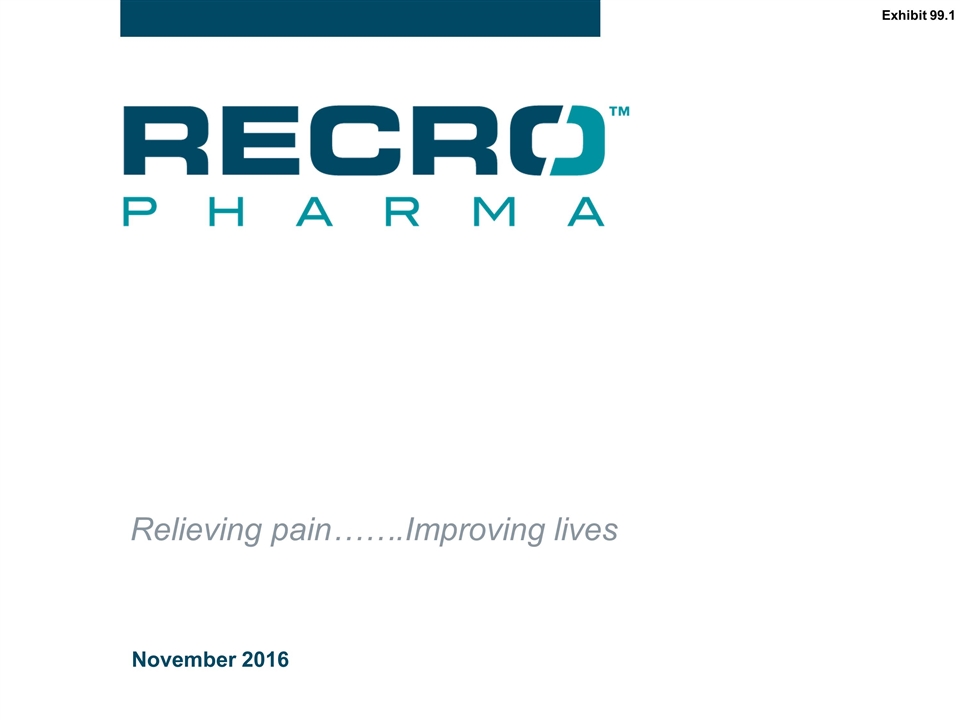
November 2016 Relieving pain…….Improving lives Exhibit 99.1
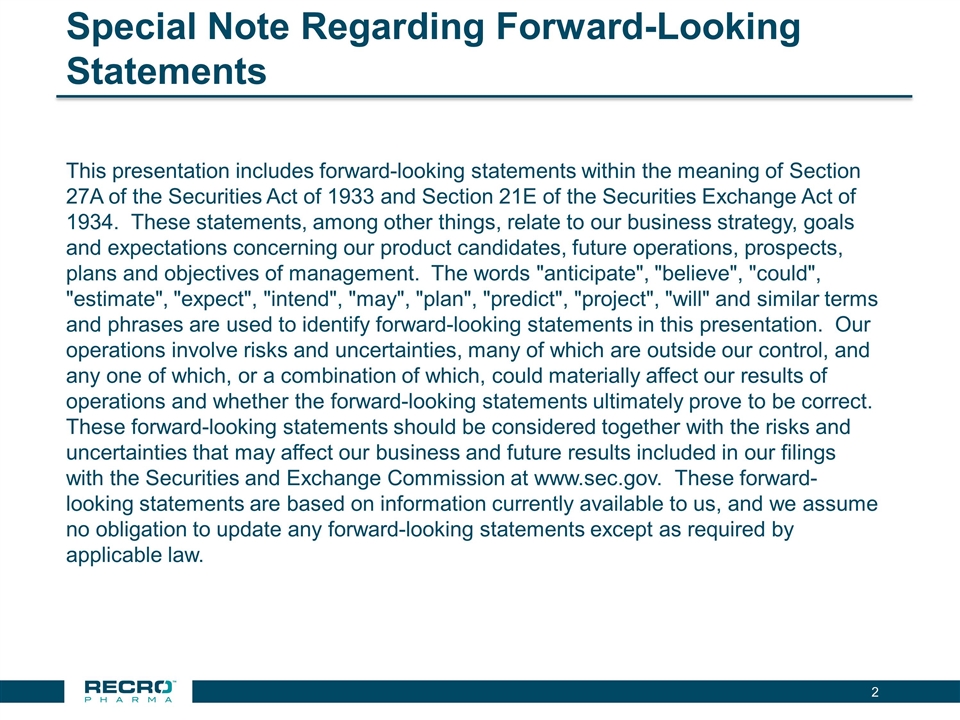
Special Note Regarding Forward-Looking Statements This presentation includes forward-looking statements within the meaning of Section 27A of the Securities Act of 1933 and Section 21E of the Securities Exchange Act of 1934. These statements, among other things, relate to our business strategy, goals and expectations concerning our product candidates, future operations, prospects, plans and objectives of management. The words "anticipate", "believe", "could", "estimate", "expect", "intend", "may", "plan", "predict", "project", "will" and similar terms and phrases are used to identify forward-looking statements in this presentation. Our operations involve risks and uncertainties, many of which are outside our control, and any one of which, or a combination of which, could materially affect our results of operations and whether the forward-looking statements ultimately prove to be correct. These forward-looking statements should be considered together with the risks and uncertainties that may affect our business and future results included in our filings with the Securities and Exchange Commission at www.sec.gov. These forward-looking statements are based on information currently available to us, and we assume no obligation to update any forward-looking statements except as required by applicable law.
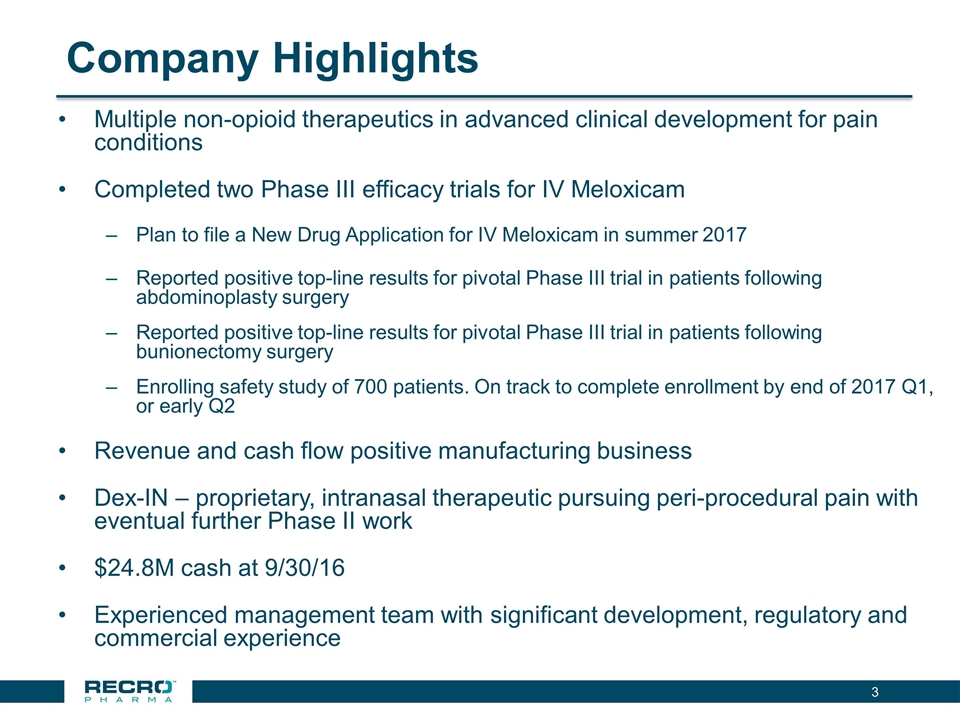
Company Highlights Multiple non-opioid therapeutics in advanced clinical development for pain conditions Completed two Phase III efficacy trials for IV Meloxicam Plan to file a New Drug Application for IV Meloxicam in summer 2017 Reported positive top-line results for pivotal Phase III trial in patients following abdominoplasty surgery Reported positive top-line results for pivotal Phase III trial in patients following bunionectomy surgery Enrolling safety study of 700 patients. On track to complete enrollment by end of 2017 Q1, or early Q2 Revenue and cash flow positive manufacturing business Dex-IN – proprietary, intranasal therapeutic pursuing peri-procedural pain with eventual further Phase II work $24.8M cash at 9/30/16 Experienced management team with significant development, regulatory and commercial experience
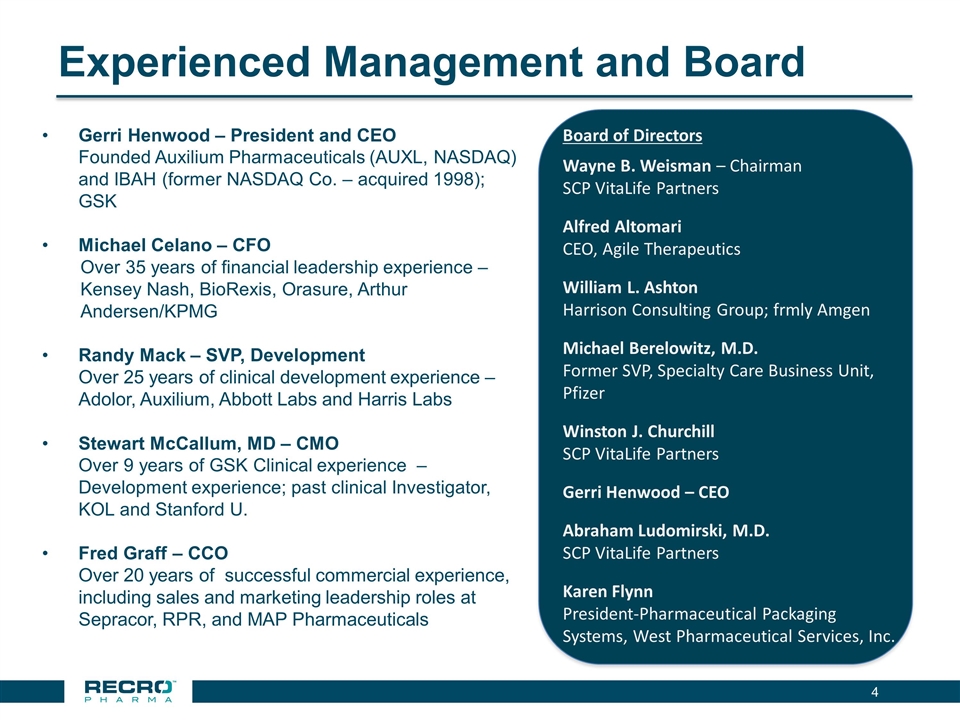
Experienced Management and Board Gerri Henwood – President and CEO Founded Auxilium Pharmaceuticals (AUXL, NASDAQ) and IBAH (former NASDAQ Co. – acquired 1998); GSK Michael Celano – CFO Over 35 years of financial leadership experience – Kensey Nash, BioRexis, Orasure, Arthur Andersen/KPMG Randy Mack – SVP, Development Over 25 years of clinical development experience – Adolor, Auxilium, Abbott Labs and Harris Labs Stewart McCallum, MD – CMO Over 9 years of GSK Clinical experience – Development experience; past clinical Investigator, KOL and Stanford U. Fred Graff – CCO Over 20 years of successful commercial experience, including sales and marketing leadership roles at Sepracor, RPR, and MAP Pharmaceuticals Board of Directors Wayne B. Weisman – Chairman SCP VitaLife Partners Alfred Altomari CEO, Agile Therapeutics William L. Ashton Harrison Consulting Group; frmly Amgen Michael Berelowitz, M.D. Former SVP, Specialty Care Business Unit, Pfizer Winston J. Churchill SCP VitaLife Partners Gerri Henwood – CEO Abraham Ludomirski, M.D. SCP VitaLife Partners Karen Flynn President-Pharmaceutical Packaging Systems, West Pharmaceutical Services, Inc.
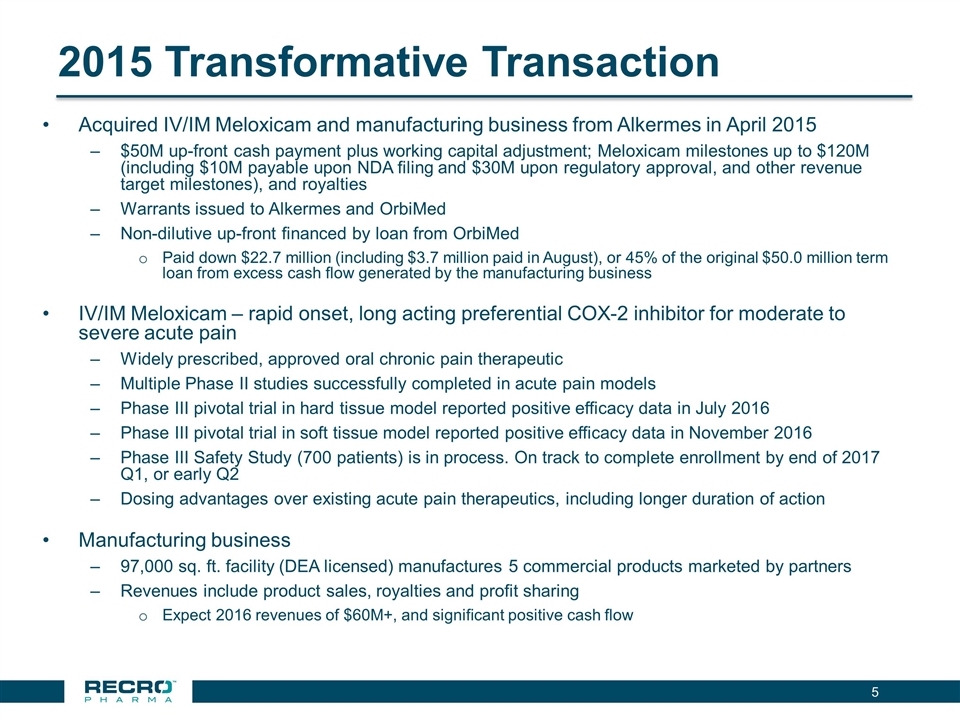
2015 Transformative Transaction Acquired IV/IM Meloxicam and manufacturing business from Alkermes in April 2015 $50M up-front cash payment plus working capital adjustment; Meloxicam milestones up to $120M (including $10M payable upon NDA filing and $30M upon regulatory approval, and other revenue target milestones), and royalties Warrants issued to Alkermes and OrbiMed Non-dilutive up-front financed by loan from OrbiMed Paid down $22.7 million (including $3.7 million paid in August), or 45% of the original $50.0 million term loan from excess cash flow generated by the manufacturing business IV/IM Meloxicam – rapid onset, long acting preferential COX-2 inhibitor for moderate to severe acute pain Widely prescribed, approved oral chronic pain therapeutic Multiple Phase II studies successfully completed in acute pain models Phase III pivotal trial in hard tissue model reported positive efficacy data in July 2016 Phase III pivotal trial in soft tissue model reported positive efficacy data in November 2016 Phase III Safety Study (700 patients) is in process. On track to complete enrollment by end of 2017 Q1, or early Q2 Dosing advantages over existing acute pain therapeutics, including longer duration of action Manufacturing business 97,000 sq. ft. facility (DEA licensed) manufactures 5 commercial products marketed by partners Revenues include product sales, royalties and profit sharing Expect 2016 revenues of $60M+, and significant positive cash flow
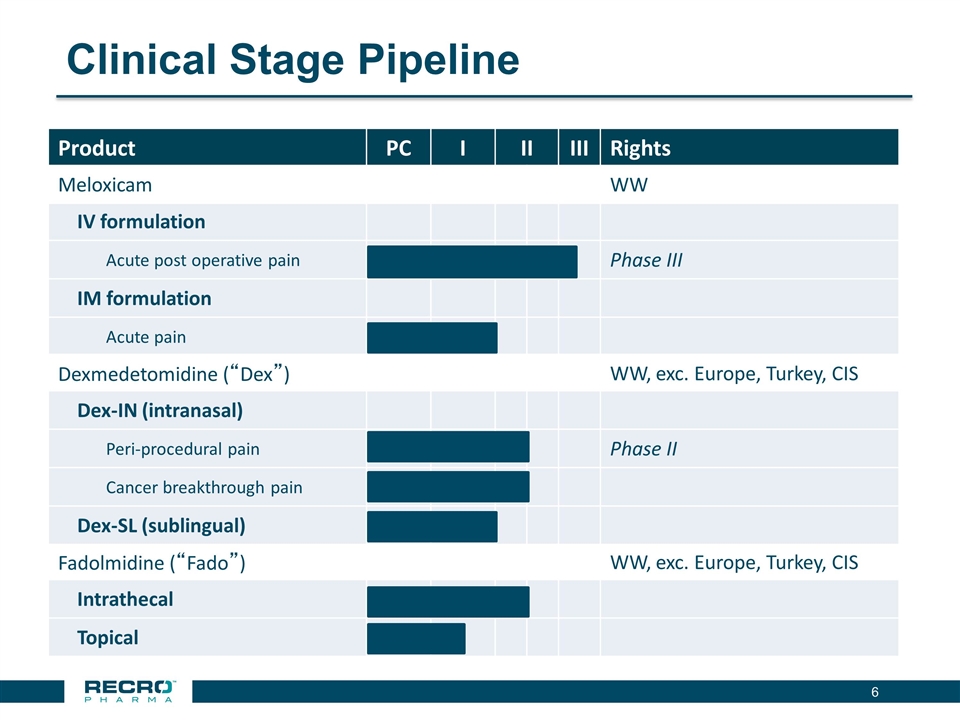
Clinical Stage Pipeline Product PC I II III Rights Meloxicam WW IV formulation Acute post operative pain Phase III IM formulation Acute pain Dexmedetomidine (“Dex”) WW, exc. Europe, Turkey, CIS Dex-IN (intranasal) Peri-procedural pain Phase II Cancer breakthrough pain Dex-SL (sublingual) Fadolmidine (“Fado”) WW, exc. Europe, Turkey, CIS Intrathecal Topical
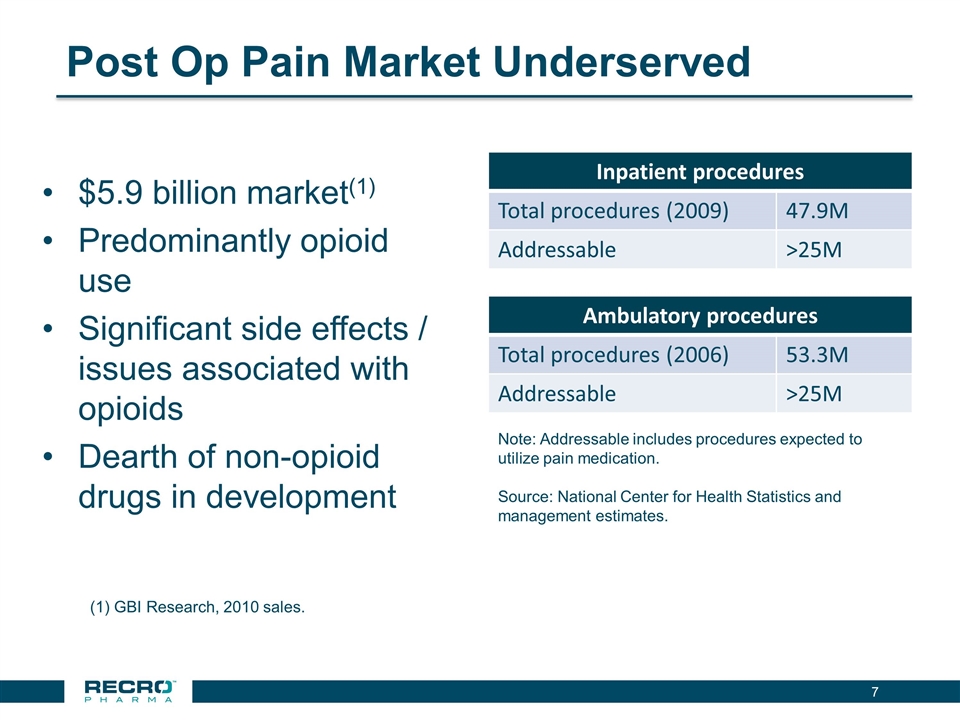
Post Op Pain Market Underserved $5.9 billion market(1) Predominantly opioid use Significant side effects / issues associated with opioids Dearth of non-opioid drugs in development Inpatient procedures Total procedures (2009) 47.9M Addressable >25M Ambulatory procedures Total procedures (2006) 53.3M Addressable >25M Note: Addressable includes procedures expected to utilize pain medication. Source: National Center for Health Statistics and management estimates. (1) GBI Research, 2010 sales.
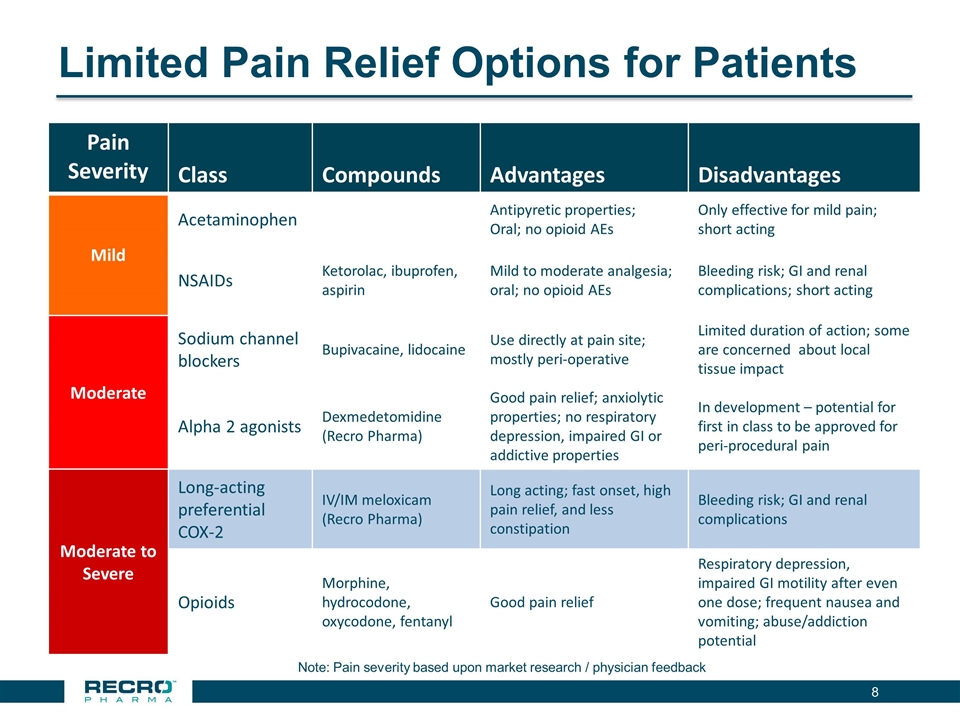
Limited Pain Relief Options for Patients Note: Pain severity based upon market research / physician feedback Pain Severity Class Compounds Advantages Disadvantages Mild Acetaminophen Antipyretic properties; Oral; no opioid AEs Only effective for mild pain; short acting NSAIDs Ketorolac, ibuprofen, aspirin Mild to moderate analgesia; oral; no opioid AEs Bleeding risk; GI and renal complications; short acting Moderate Sodium channel blockers Bupivacaine, lidocaine Use directly at pain site; mostly peri-operative Limited duration of action; some are concerned about local tissue impact Alpha 2 agonists Dexmedetomidine (Recro Pharma) Good pain relief; anxiolytic properties; no respiratory depression, impaired GI or addictive properties In development – potential for first in class to be approved for peri-procedural pain Moderate to Severe Long-acting preferential COX-2 IV/IM meloxicam (Recro Pharma) Long acting; fast onset, high pain relief, and less constipation Bleeding risk; GI and renal complications Opioids Morphine, hydrocodone, oxycodone, fentanyl Good pain relief Respiratory depression, impaired GI motility after even one dose; frequent nausea and vomiting; abuse/addiction potential
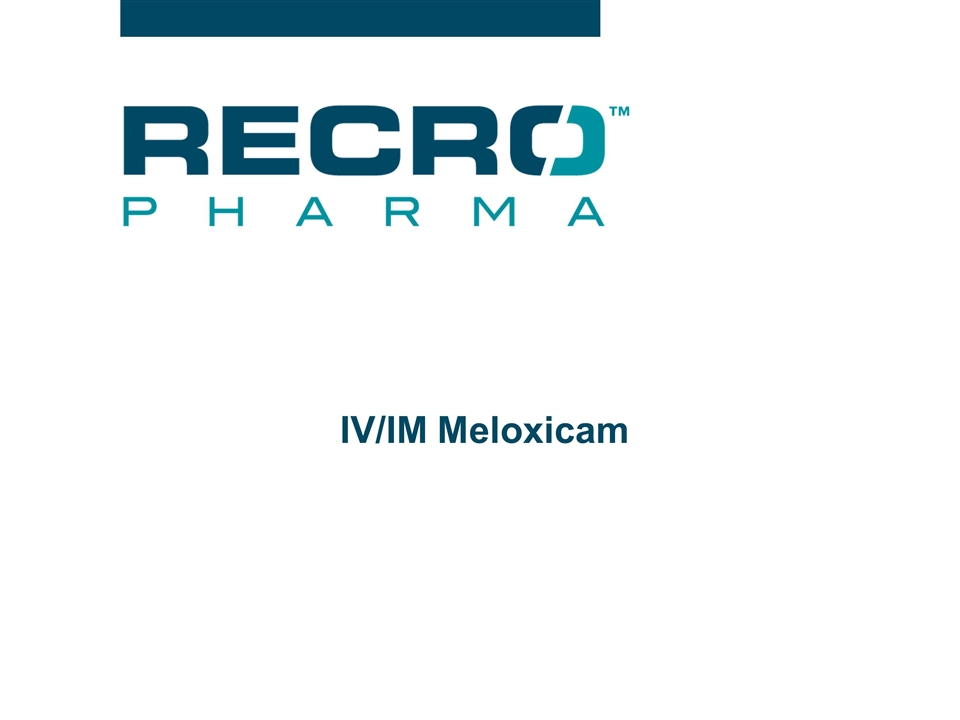
IV/IM Meloxicam
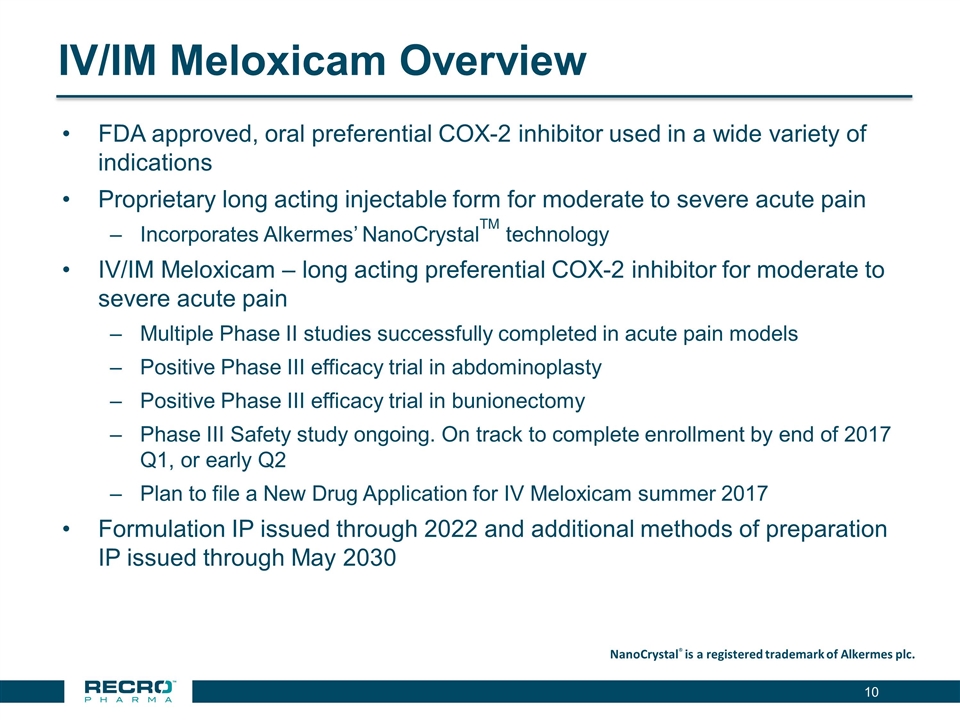
IV/IM Meloxicam Overview FDA approved, oral preferential COX-2 inhibitor used in a wide variety of indications Proprietary long acting injectable form for moderate to severe acute pain Incorporates Alkermes’ NanoCrystalTM technology IV/IM Meloxicam – long acting preferential COX-2 inhibitor for moderate to severe acute pain Multiple Phase II studies successfully completed in acute pain models Positive Phase III efficacy trial in abdominoplasty Positive Phase III efficacy trial in bunionectomy Phase III Safety study ongoing. On track to complete enrollment by end of 2017 Q1, or early Q2 Plan to file a New Drug Application for IV Meloxicam summer 2017 Formulation IP issued through 2022 and additional methods of preparation IP issued through May 2030 NanoCrystal® is a registered trademark of Alkermes plc.
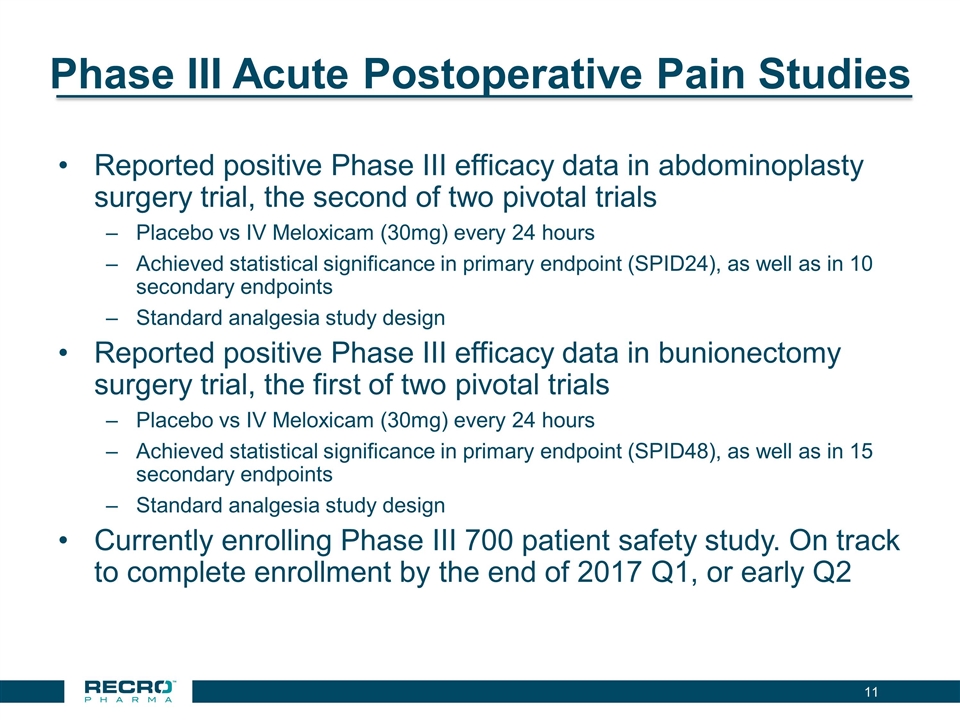
Phase III Acute Postoperative Pain Studies Reported positive Phase III efficacy data in abdominoplasty surgery trial, the second of two pivotal trials Placebo vs IV Meloxicam (30mg) every 24 hours Achieved statistical significance in primary endpoint (SPID24), as well as in 10 secondary endpoints Standard analgesia study design Reported positive Phase III efficacy data in bunionectomy surgery trial, the first of two pivotal trials Placebo vs IV Meloxicam (30mg) every 24 hours Achieved statistical significance in primary endpoint (SPID48), as well as in 15 secondary endpoints Standard analgesia study design Currently enrolling Phase III 700 patient safety study. On track to complete enrollment by the end of 2017 Q1, or early Q2
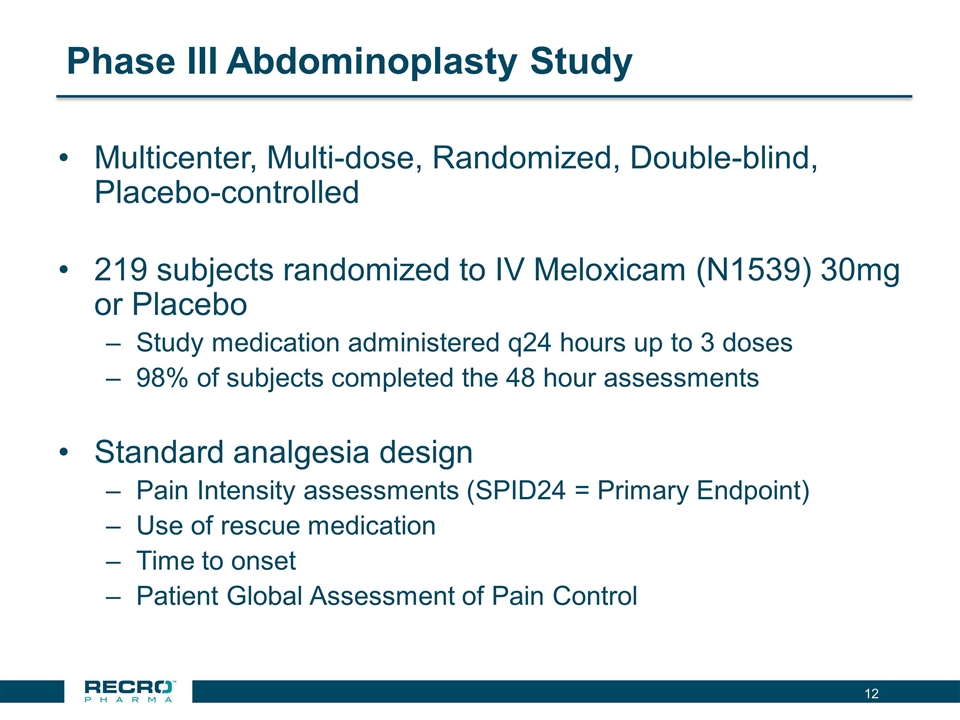
Phase III Abdominoplasty Study Multicenter, Multi-dose, Randomized, Double-blind, Placebo-controlled 219 subjects randomized to IV Meloxicam (N1539) 30mg or Placebo Study medication administered q24 hours up to 3 doses 98% of subjects completed the 48 hour assessments Standard analgesia design Pain Intensity assessments (SPID24 = Primary Endpoint) Use of rescue medication Time to onset Patient Global Assessment of Pain Control
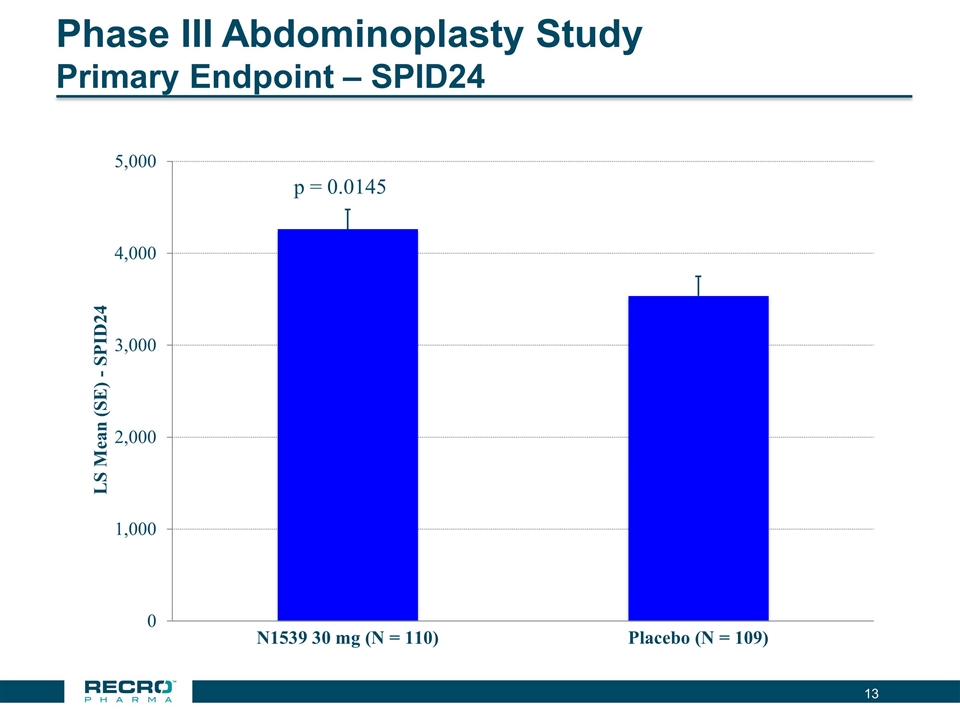
Phase III Abdominoplasty Study Primary Endpoint – SPID24 p = 0.0145
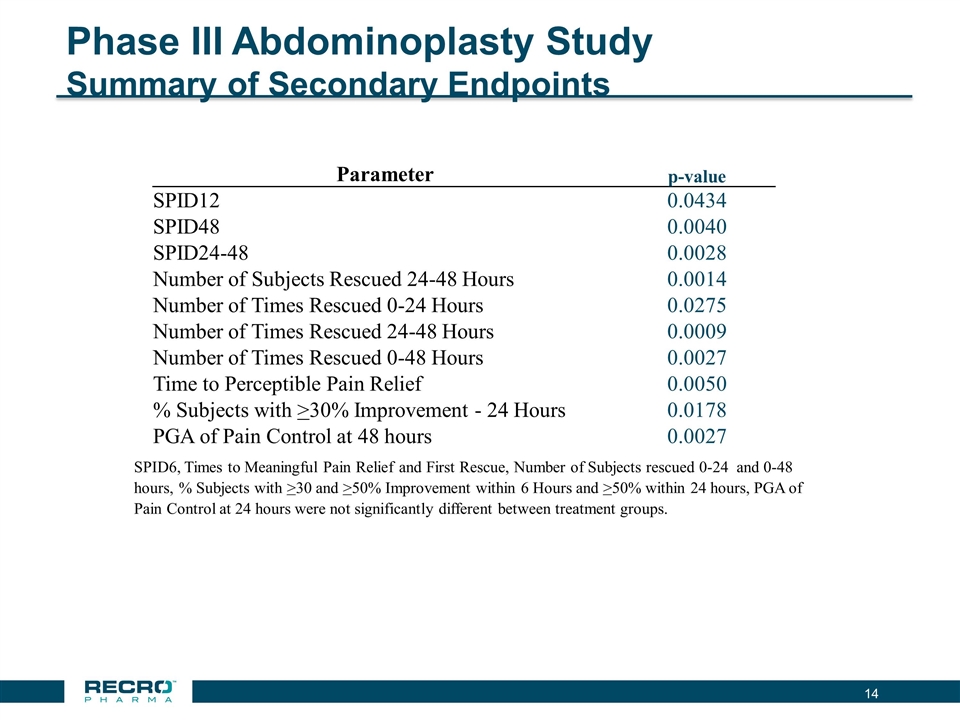
Phase III Abdominoplasty Study Summary of Secondary Endpoints SPID6, Times to Meaningful Pain Relief and First Rescue, Number of Subjects rescued 0-24 and 0-48 hours, % Subjects with >30 and >50% Improvement within 6 Hours and >50% within 24 hours, PGA of Pain Control at 24 hours were not significantly different between treatment groups. Parameter p-value SPID12 0.0434 SPID48 0.0040 SPID24-48 0.0028 Number of Subjects Rescued 24-48 Hours 0.0014 Number of Times Rescued 0-24 Hours 0.0275 Number of Times Rescued 24-48 Hours 0.0009 Number of Times Rescued 0-48 Hours 0.0027 Time to Perceptible Pain Relief 0.0050 % Subjects with >30% Improvement - 24 Hours 0.0178 PGA of Pain Control at 48 hours 0.0027
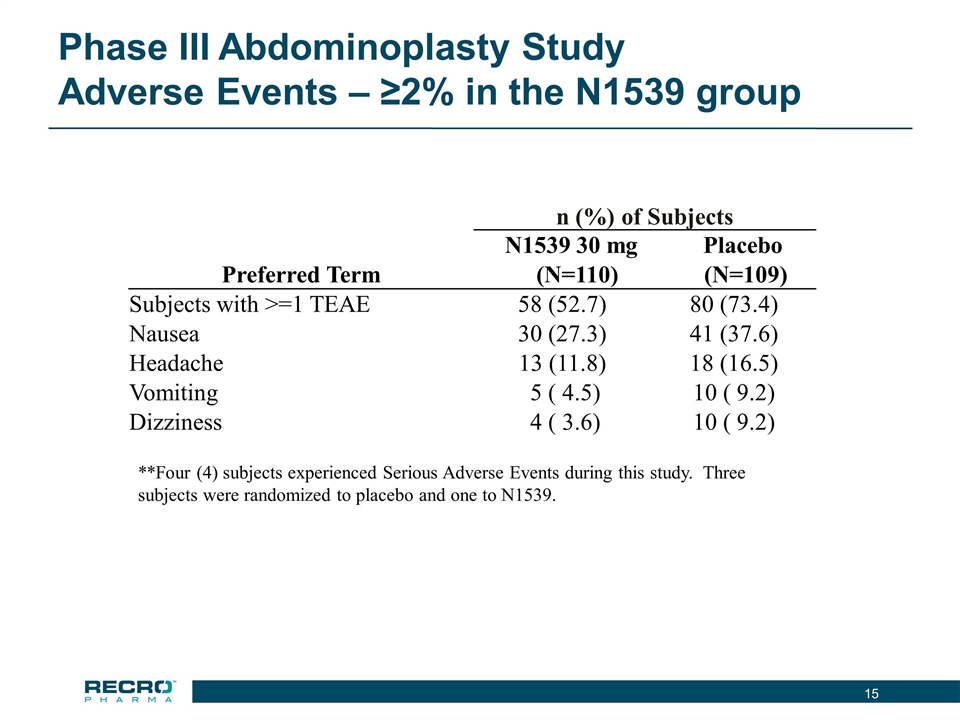
Phase III Abdominoplasty Study Adverse Events – ≥2% in the N1539 group n (%) of Subjects N1539 30 mg Placebo Preferred Term (N=110) (N=109) Subjects with >=1 TEAE 58 (52.7) 80 (73.4) Nausea 30 (27.3) 41 (37.6) Headache 13 (11.8) 18 (16.5) Vomiting 5 ( 4.5) 10 ( 9.2) Dizziness 4 ( 3.6) 10 ( 9.2) **Four (4) subjects experienced Serious Adverse Events during this study. Three subjects were randomized to placebo and one to N1539.
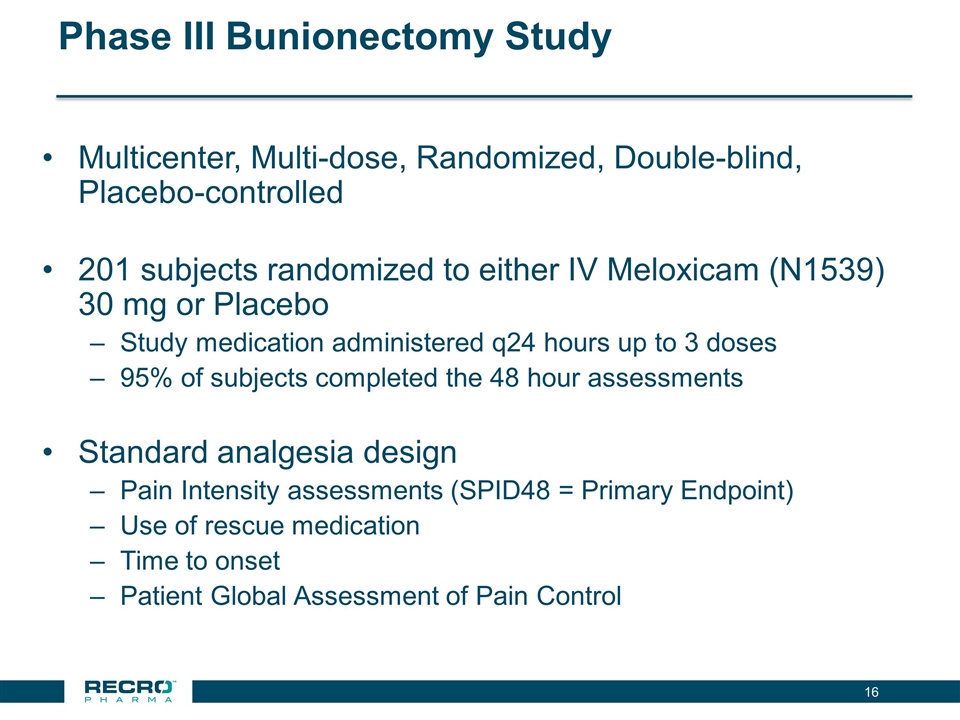
Phase III Bunionectomy Study Multicenter, Multi-dose, Randomized, Double-blind, Placebo-controlled 201 subjects randomized to either IV Meloxicam (N1539) 30 mg or Placebo Study medication administered q24 hours up to 3 doses 95% of subjects completed the 48 hour assessments Standard analgesia design Pain Intensity assessments (SPID48 = Primary Endpoint) Use of rescue medication Time to onset Patient Global Assessment of Pain Control
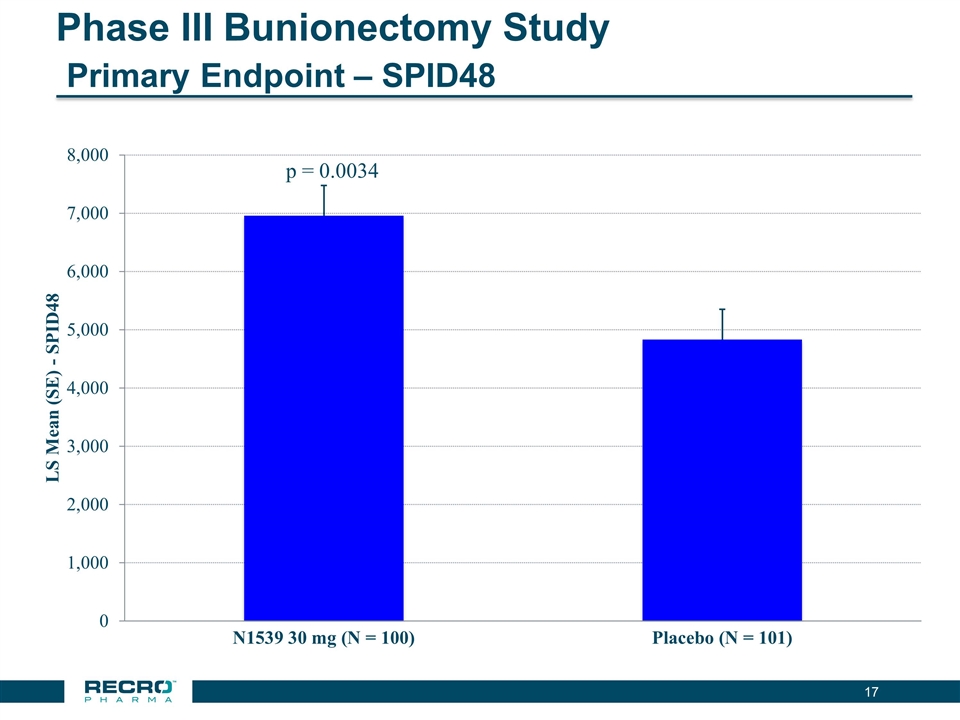
Phase III Bunionectomy Study Primary Endpoint – SPID48 p = 0.0034
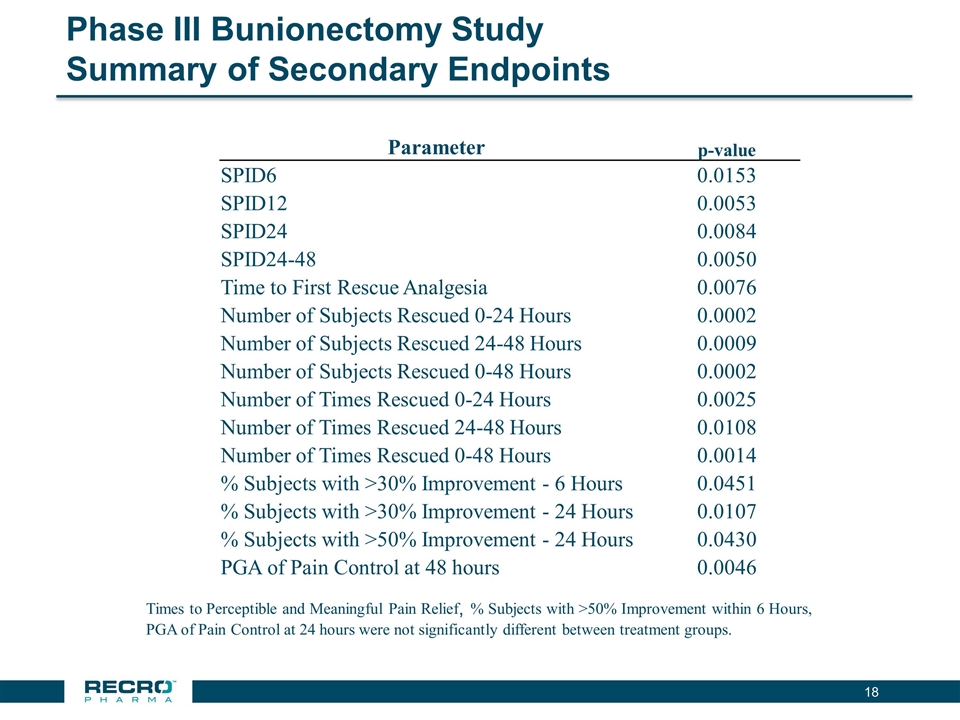
Phase III Bunionectomy Study Summary of Secondary Endpoints Parameter p-value SPID6 0.0153 SPID12 0.0053 SPID24 0.0084 SPID24-48 0.0050 Time to First Rescue Analgesia 0.0076 Number of Subjects Rescued 0-24 Hours 0.0002 Number of Subjects Rescued 24-48 Hours 0.0009 Number of Subjects Rescued 0-48 Hours 0.0002 Number of Times Rescued 0-24 Hours 0.0025 Number of Times Rescued 24-48 Hours 0.0108 Number of Times Rescued 0-48 Hours 0.0014 % Subjects with >30% Improvement - 6 Hours 0.0451 % Subjects with >30% Improvement - 24 Hours 0.0107 % Subjects with >50% Improvement - 24 Hours 0.0430 PGA of Pain Control at 48 hours 0.0046 Times to Perceptible and Meaningful Pain Relief, % Subjects with >50% Improvement within 6 Hours, PGA of Pain Control at 24 hours were not significantly different between treatment groups.
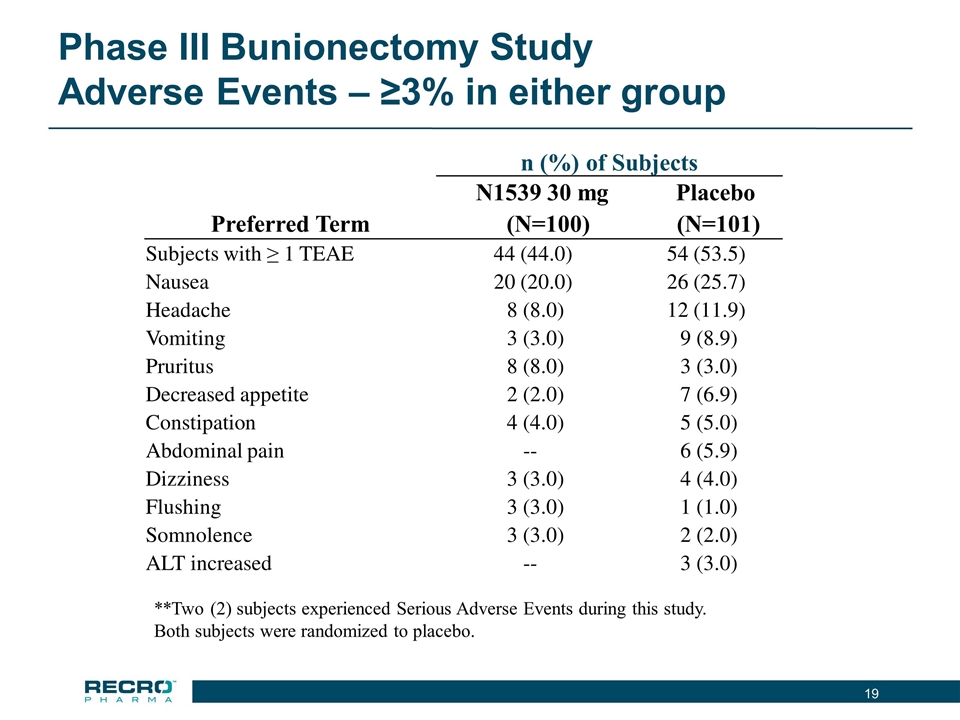
Phase III Bunionectomy Study Adverse Events – ≥3% in either group n (%) of Subjects N1539 30 mg Placebo Preferred Term (N=100) (N=101) Subjects with ≥ 1 TEAE 44 (44.0) 54 (53.5) Nausea 20 (20.0) 26 (25.7) Headache 8 (8.0) 12 (11.9) Vomiting 3 (3.0) 9 (8.9) Pruritus 8 (8.0) 3 (3.0) Decreased appetite 2 (2.0) 7 (6.9) Constipation 4 (4.0) 5 (5.0) Abdominal pain -- 6 (5.9) Dizziness 3 (3.0) 4 (4.0) Flushing 3 (3.0) 1 (1.0) Somnolence 3 (3.0) 2 (2.0) ALT increased -- 3 (3.0) **Two (2) subjects experienced Serious Adverse Events during this study. Both subjects were randomized to placebo.
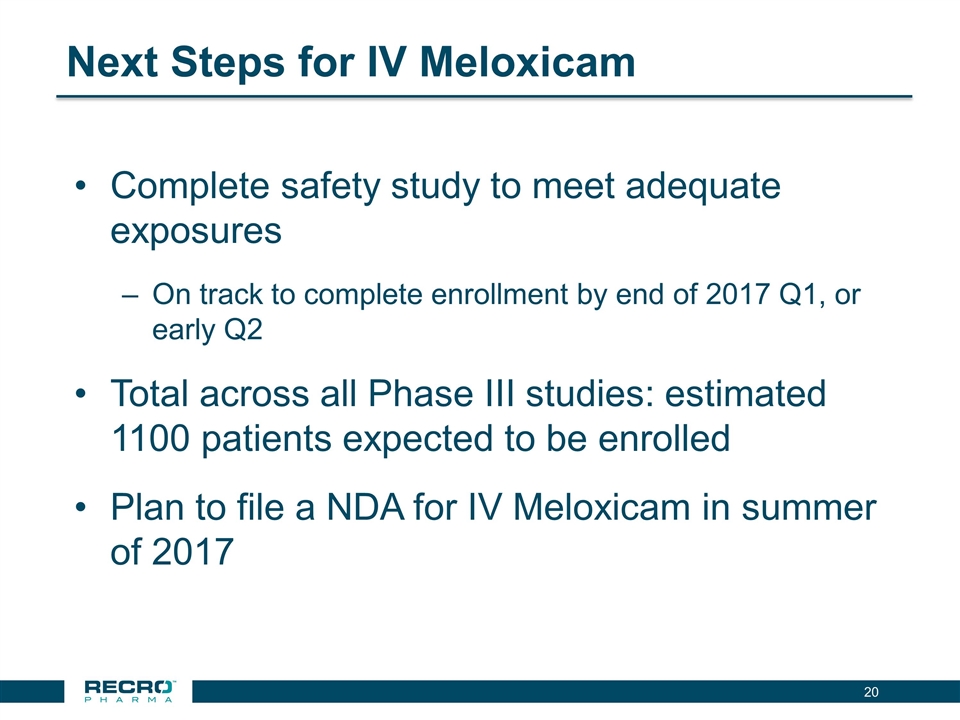
Next Steps for IV Meloxicam Complete safety study to meet adequate exposures On track to complete enrollment by end of 2017 Q1, or early Q2 Total across all Phase III studies: estimated 1100 patients expected to be enrolled Plan to file a NDA for IV Meloxicam in summer of 2017
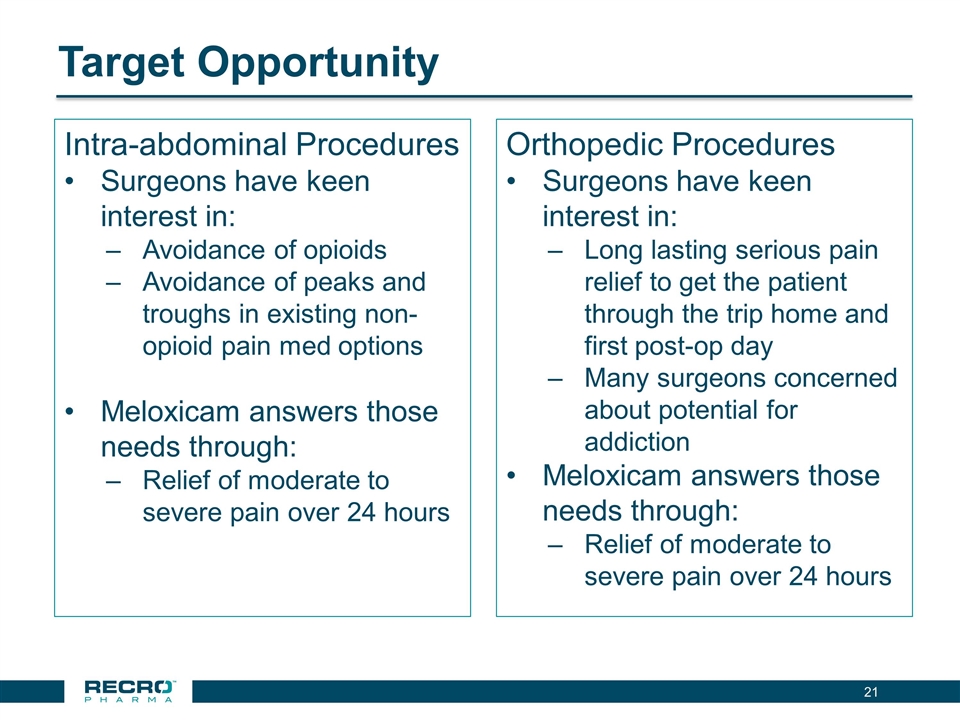
Target Opportunity Intra-abdominal Procedures Surgeons have keen interest in: Avoidance of opioids Avoidance of peaks and troughs in existing non-opioid pain med options Meloxicam answers those needs through: Relief of moderate to severe pain over 24 hours Orthopedic Procedures Surgeons have keen interest in: Long lasting serious pain relief to get the patient through the trip home and first post-op day Many surgeons concerned about potential for addiction Meloxicam answers those needs through: Relief of moderate to severe pain over 24 hours
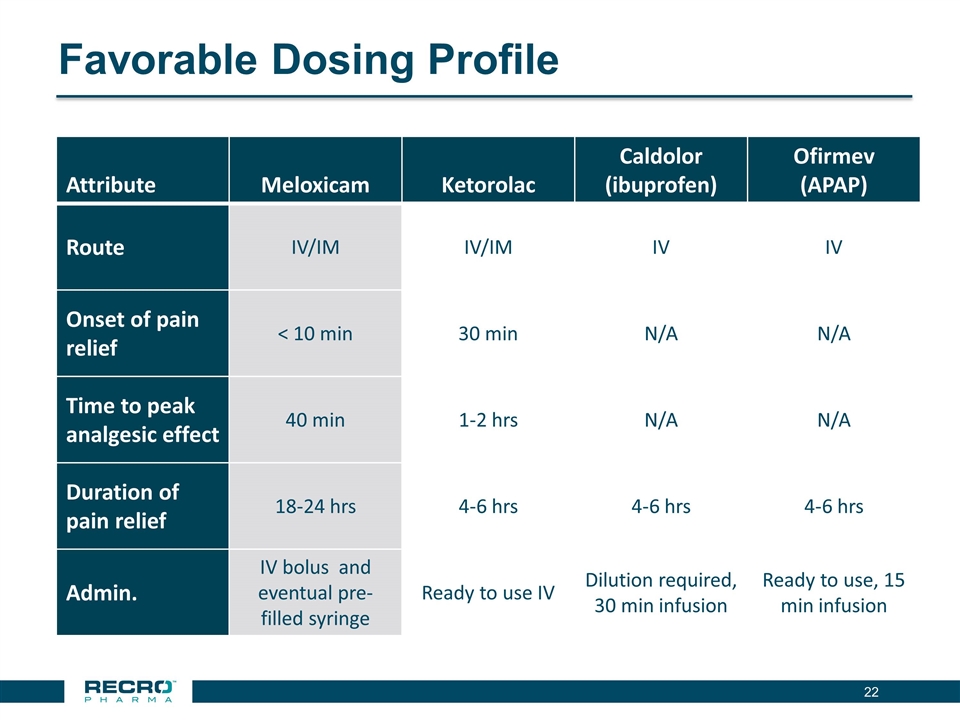
Favorable Dosing Profile Attribute Meloxicam Ketorolac Caldolor (ibuprofen) Ofirmev (APAP) Route IV/IM IV/IM IV IV Onset of pain relief < 10 min 30 min N/A N/A Time to peak analgesic effect 40 min 1-2 hrs N/A N/A Duration of pain relief 18-24 hrs 4-6 hrs 4-6 hrs 4-6 hrs Admin. IV bolus and eventual pre-filled syringe Ready to use IV Dilution required, 30 min infusion Ready to use, 15 min infusion
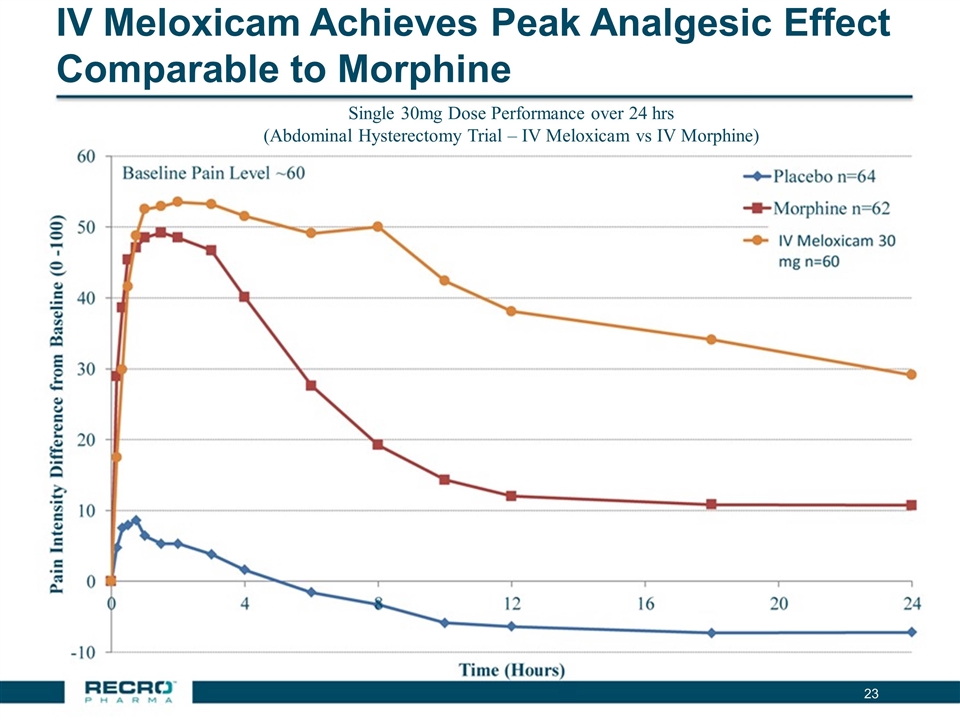
IV Meloxicam Achieves Peak Analgesic Effect Comparable to Morphine Single 30mg Dose Performance over 24 hrs (Abdominal Hysterectomy Trial – IV Meloxicam vs IV Morphine)
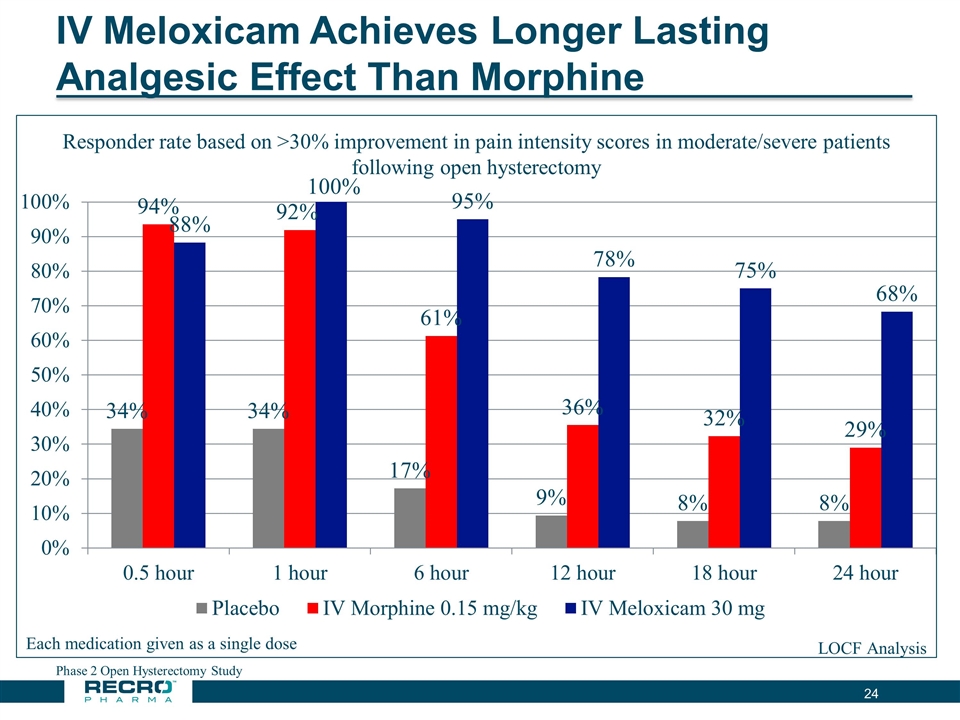
IV Meloxicam Achieves Longer Lasting Analgesic Effect Than Morphine Phase 2 Open Hysterectomy Study
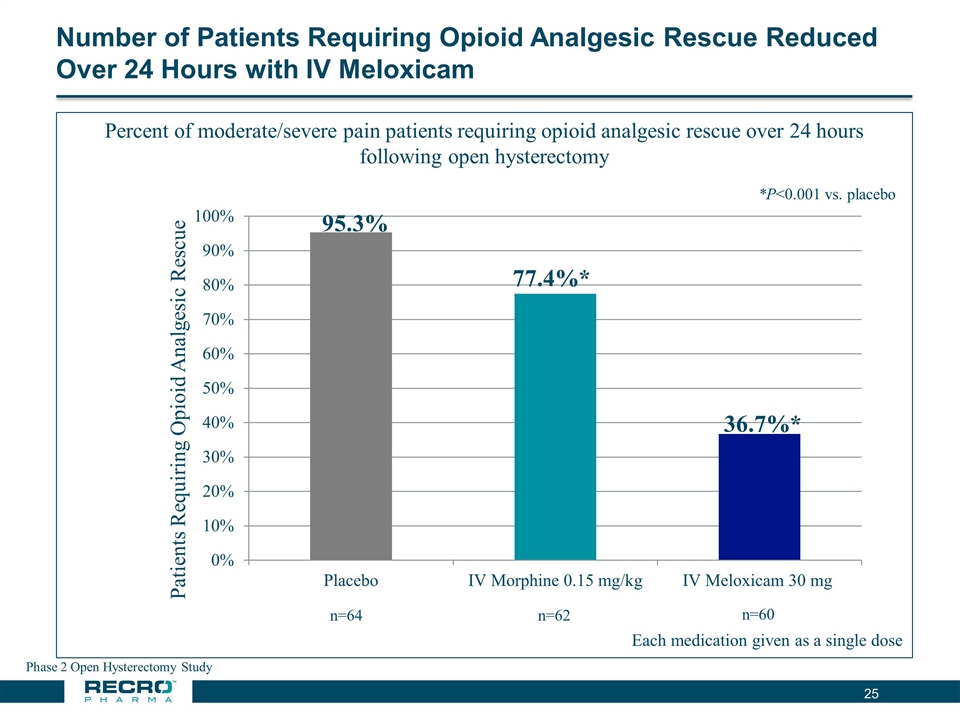
Number of Patients Requiring Opioid Analgesic Rescue Reduced Over 24 Hours with IV Meloxicam Phase 2 Open Hysterectomy Study *P<0.001 vs. placebo 77.4%* 36.7%*
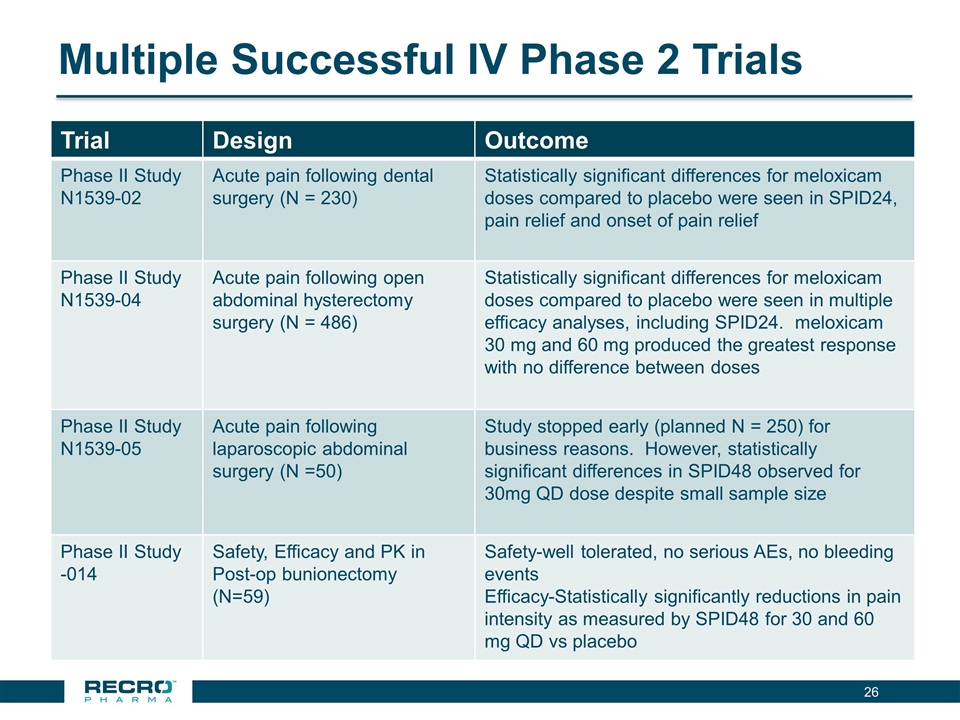
Multiple Successful IV Phase 2 Trials Trial Design Outcome Phase II Study N1539-02 Acute pain following dental surgery (N = 230) Statistically significant differences for meloxicam doses compared to placebo were seen in SPID24, pain relief and onset of pain relief Phase II Study N1539-04 Acute pain following open abdominal hysterectomy surgery (N = 486) Statistically significant differences for meloxicam doses compared to placebo were seen in multiple efficacy analyses, including SPID24. meloxicam 30 mg and 60 mg produced the greatest response with no difference between doses Phase II Study N1539-05 Acute pain following laparoscopic abdominal surgery (N =50) Study stopped early (planned N = 250) for business reasons. However, statistically significant differences in SPID48 observed for 30mg QD dose despite small sample size Phase II Study -014 Safety, Efficacy and PK in Post-op bunionectomy (N=59) Safety-well tolerated, no serious AEs, no bleeding events Efficacy-Statistically significantly reductions in pain intensity as measured by SPID48 for 30 and 60 mg QD vs placebo
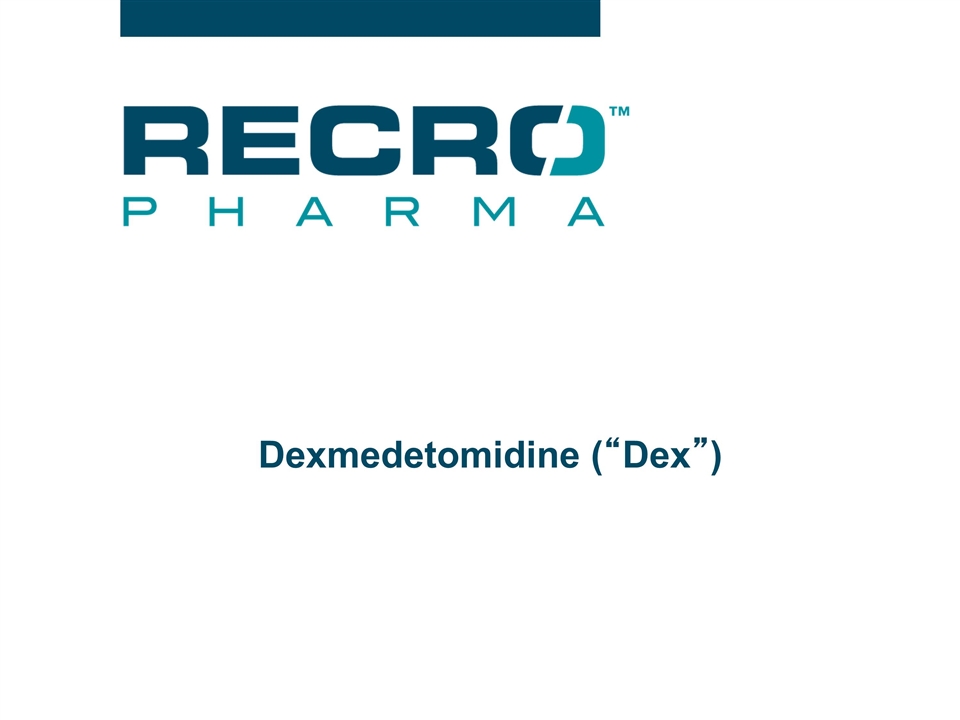
Dexmedetomidine (“Dex”)
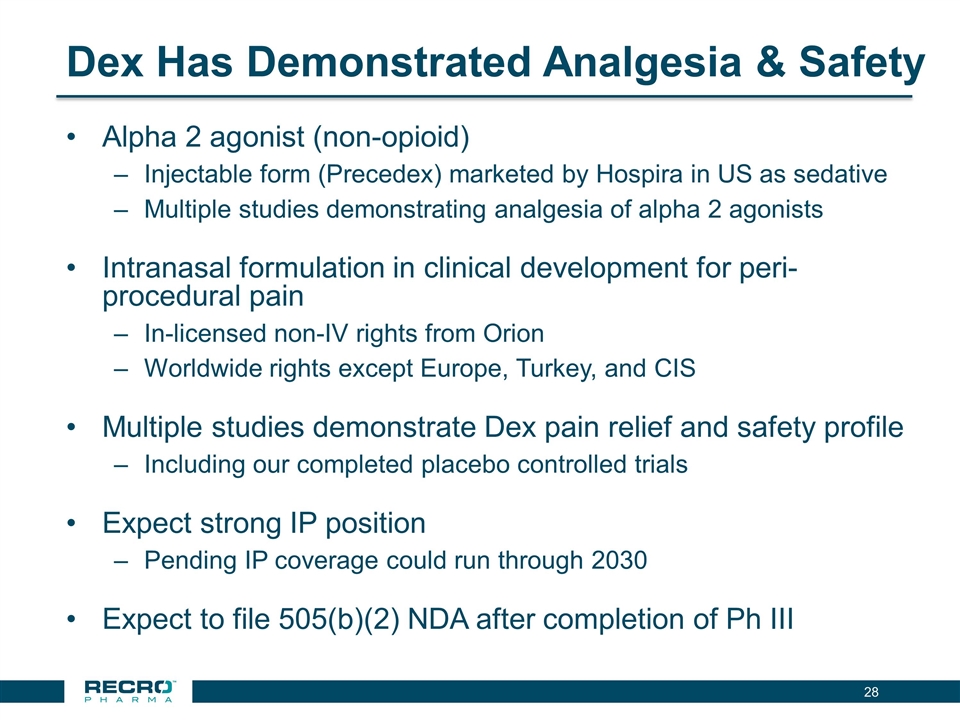
Dex Has Demonstrated Analgesia & Safety Alpha 2 agonist (non-opioid) Injectable form (Precedex) marketed by Hospira in US as sedative Multiple studies demonstrating analgesia of alpha 2 agonists Intranasal formulation in clinical development for peri-procedural pain In-licensed non-IV rights from Orion Worldwide rights except Europe, Turkey, and CIS Multiple studies demonstrate Dex pain relief and safety profile Including our completed placebo controlled trials Expect strong IP position Pending IP coverage could run through 2030 Expect to file 505(b)(2) NDA after completion of Ph III
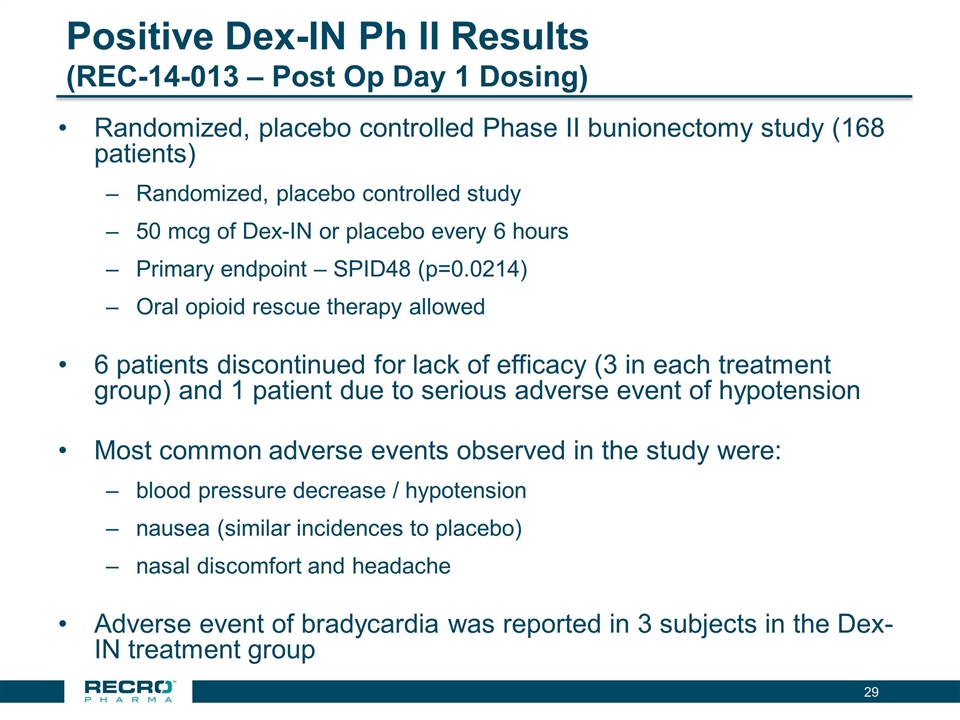
Positive Dex-IN Ph II Results (REC-14-013 – Post Op Day 1 Dosing) Randomized, placebo controlled Phase II bunionectomy study (168 patients) Randomized, placebo controlled study 50 mcg of Dex-IN or placebo every 6 hours Primary endpoint – SPID48 (p=0.0214) Oral opioid rescue therapy allowed 6 patients discontinued for lack of efficacy (3 in each treatment group) and 1 patient due to serious adverse event of hypotension Most common adverse events observed in the study were: blood pressure decrease / hypotension nausea (similar incidences to placebo) nasal discomfort and headache Adverse event of bradycardia was reported in 3 subjects in the Dex-IN treatment group
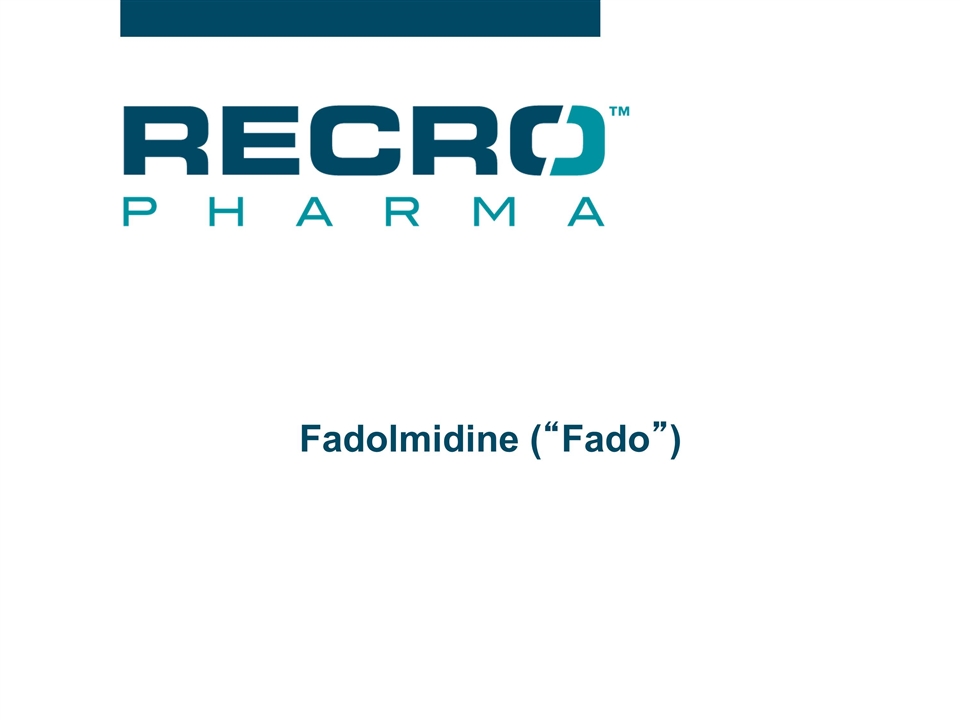
Fadolmidine (“Fado”)
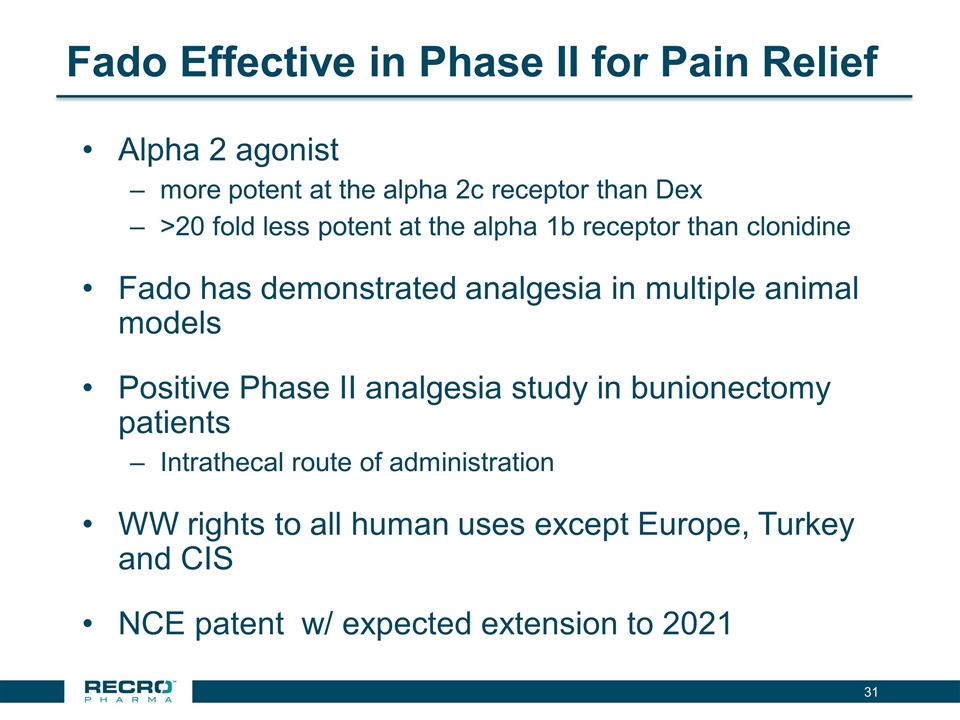
Fado Effective in Phase II for Pain Relief Alpha 2 agonist more potent at the alpha 2c receptor than Dex >20 fold less potent at the alpha 1b receptor than clonidine Fado has demonstrated analgesia in multiple animal models Positive Phase II analgesia study in bunionectomy patients Intrathecal route of administration WW rights to all human uses except Europe, Turkey and CIS NCE patent w/ expected extension to 2021
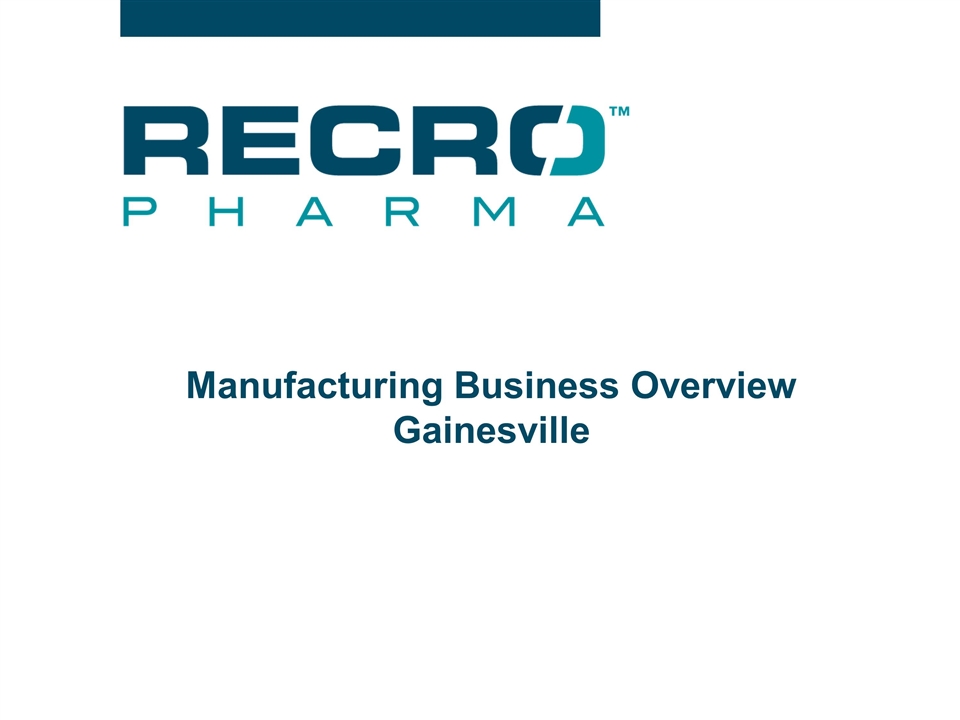
Manufacturing Business Overview Gainesville

Gainesville Manufacturing Facility
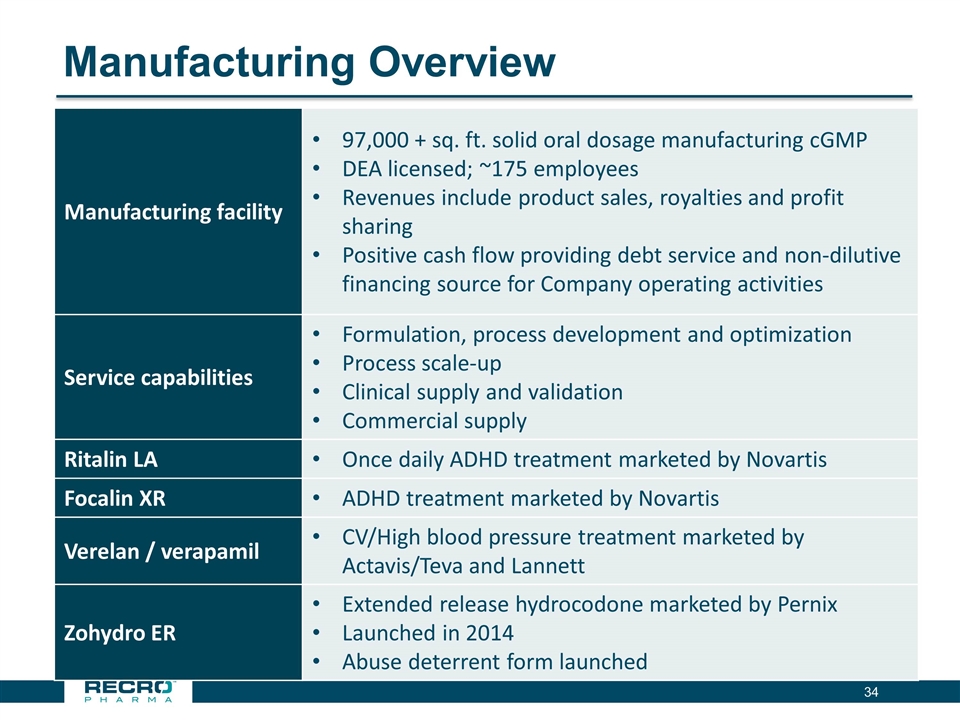
Manufacturing Overview Manufacturing facility 97,000 + sq. ft. solid oral dosage manufacturing cGMP DEA licensed; ~175 employees Revenues include product sales, royalties and profit sharing Positive cash flow providing debt service and non-dilutive financing source for Company operating activities Service capabilities Formulation, process development and optimization Process scale-up Clinical supply and validation Commercial supply Ritalin LA Once daily ADHD treatment marketed by Novartis Focalin XR ADHD treatment marketed by Novartis Verelan / verapamil CV/High blood pressure treatment marketed by Actavis/Teva and Lannett Zohydro ER Extended release hydrocodone marketed by Pernix Launched in 2014 Abuse deterrent form launched
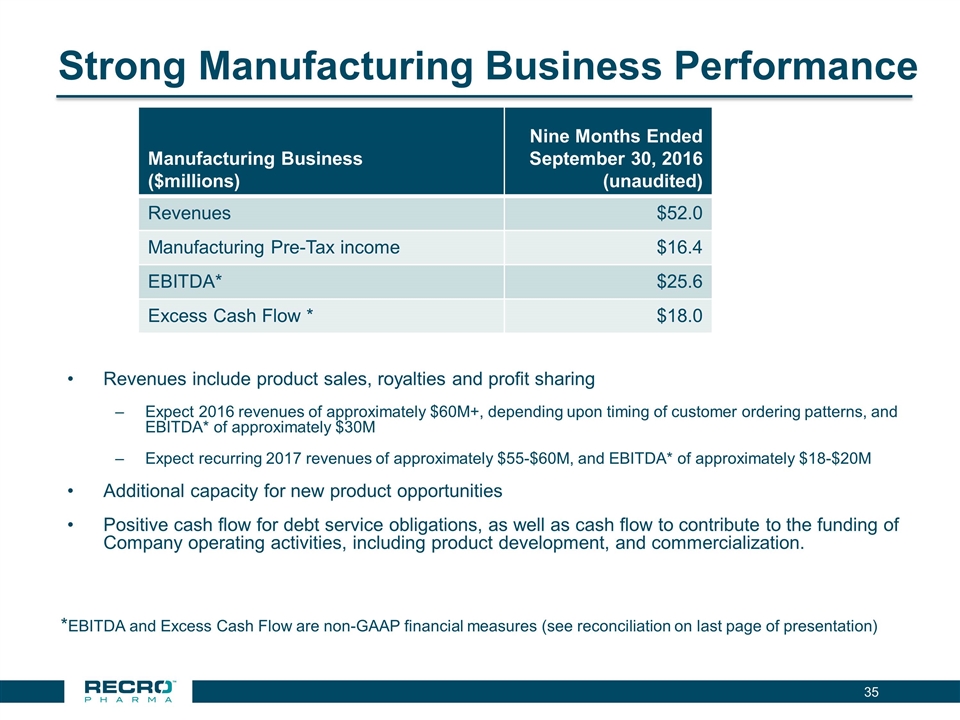
Strong Manufacturing Business Performance Revenues include product sales, royalties and profit sharing Expect 2016 revenues of approximately $60M+, depending upon timing of customer ordering patterns, and EBITDA* of approximately $30M Expect recurring 2017 revenues of approximately $55-$60M, and EBITDA* of approximately $18-$20M Additional capacity for new product opportunities Positive cash flow for debt service obligations, as well as cash flow to contribute to the funding of Company operating activities, including product development, and commercialization. *EBITDA and Excess Cash Flow are non-GAAP financial measures (see reconciliation on last page of presentation) Manufacturing Business ($millions) Nine Months Ended September 30, 2016 (unaudited) Revenues $52.0 Manufacturing Pre-Tax income $16.4 EBITDA* $25.6 Excess Cash Flow * $18.0
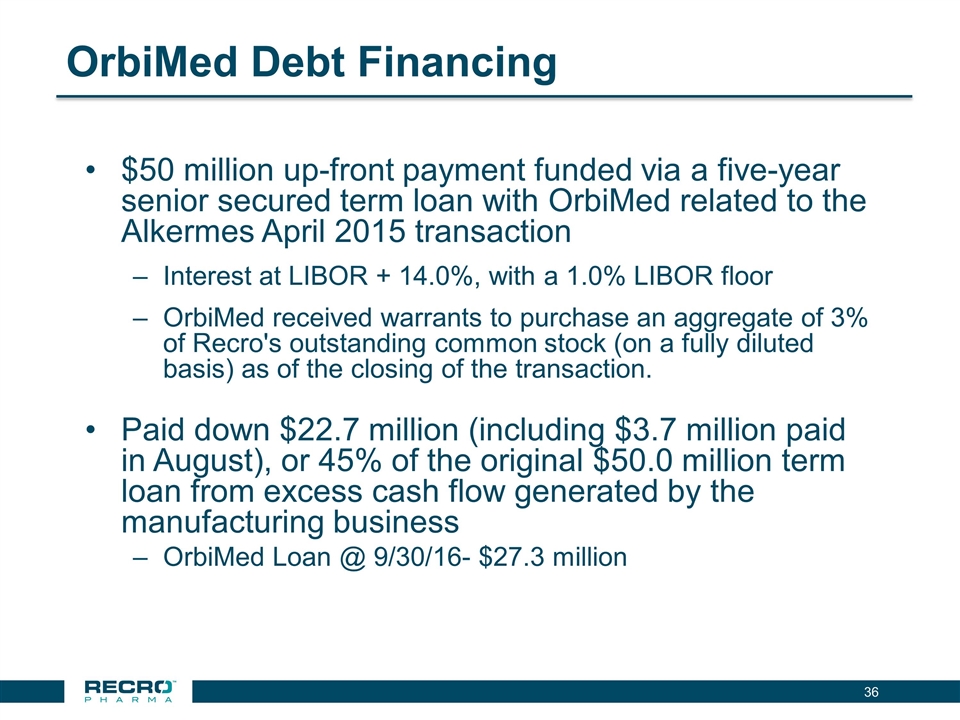
OrbiMed Debt Financing $50 million up-front payment funded via a five-year senior secured term loan with OrbiMed related to the Alkermes April 2015 transaction Interest at LIBOR + 14.0%, with a 1.0% LIBOR floor OrbiMed received warrants to purchase an aggregate of 3% of Recro's outstanding common stock (on a fully diluted basis) as of the closing of the transaction. Paid down $22.7 million (including $3.7 million paid in August), or 45% of the original $50.0 million term loan from excess cash flow generated by the manufacturing business OrbiMed Loan @ 9/30/16- $27.3 million
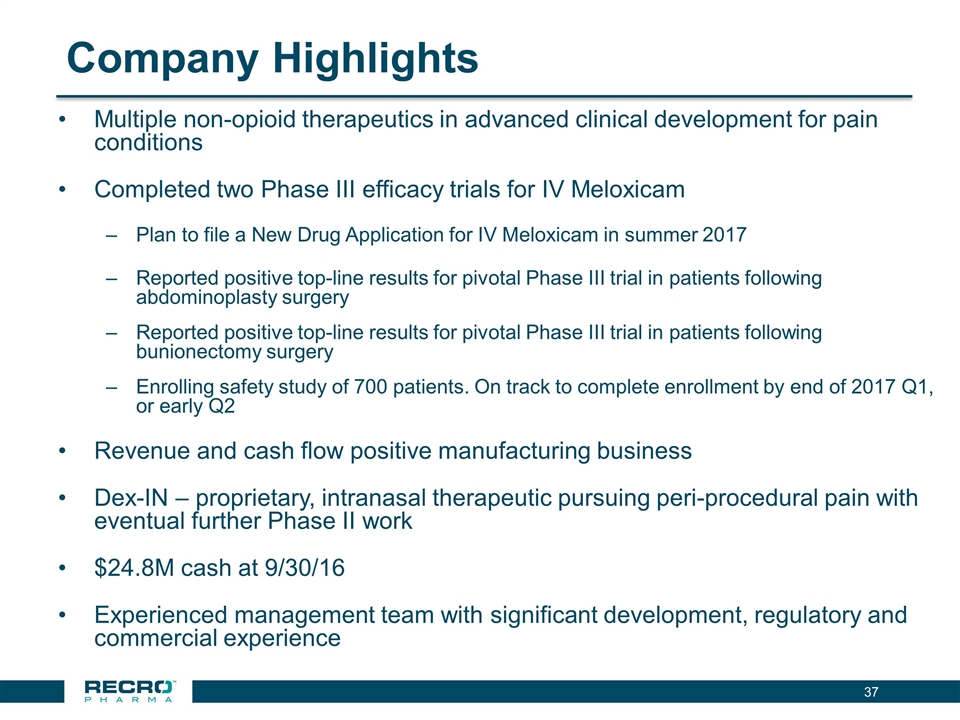
Company Highlights Multiple non-opioid therapeutics in advanced clinical development for pain conditions Completed two Phase III efficacy trials for IV Meloxicam Plan to file a New Drug Application for IV Meloxicam in summer 2017 Reported positive top-line results for pivotal Phase III trial in patients following abdominoplasty surgery Reported positive top-line results for pivotal Phase III trial in patients following bunionectomy surgery Enrolling safety study of 700 patients. On track to complete enrollment by end of 2017 Q1, or early Q2 Revenue and cash flow positive manufacturing business Dex-IN – proprietary, intranasal therapeutic pursuing peri-procedural pain with eventual further Phase II work $24.8M cash at 9/30/16 Experienced management team with significant development, regulatory and commercial experience
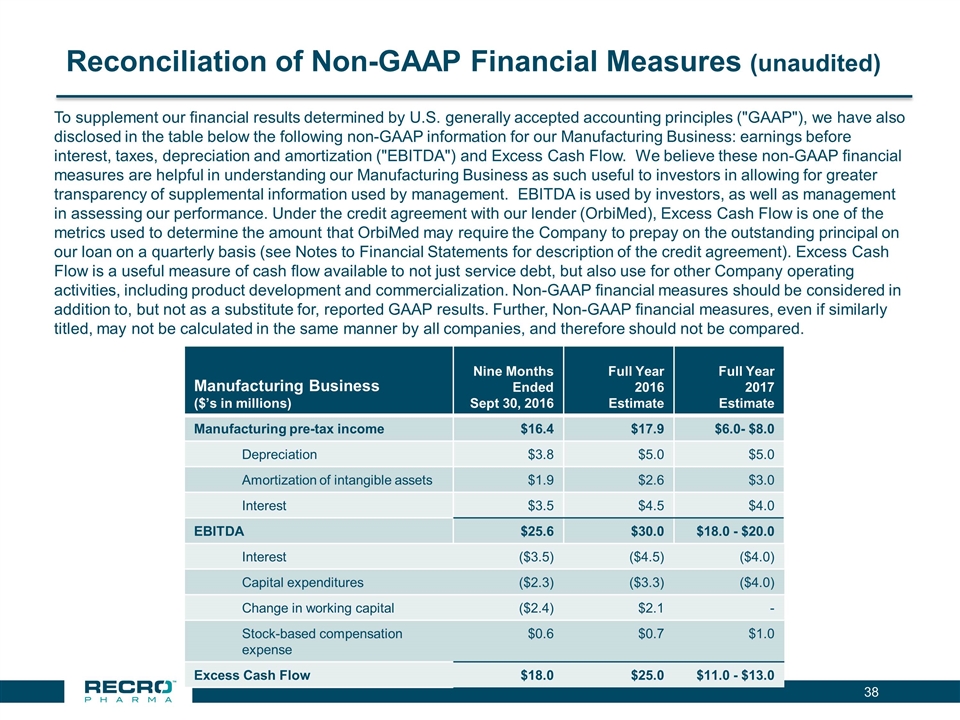
Reconciliation of Non-GAAP Financial Measures (unaudited) Manufacturing Business ($’s in millions) Nine Months Ended Sept 30, 2016 Full Year 2016 Estimate Full Year 2017 Estimate Manufacturing pre-tax income $16.4 $17.9 $6.0- $8.0 Depreciation $3.8 $5.0 $5.0 Amortization of intangible assets $1.9 $2.6 $3.0 Interest $3.5 $4.5 $4.0 EBITDA $25.6 $30.0 $18.0 - $20.0 Interest ($3.5) ($4.5) ($4.0) Capital expenditures ($2.3) ($3.3) ($4.0) Change in working capital ($2.4) $2.1 - Stock-based compensation expense $0.6 $0.7 $1.0 Excess Cash Flow $18.0 $25.0 $11.0 - $13.0 To supplement our financial results determined by U.S. generally accepted accounting principles ("GAAP"), we have also disclosed in the table below the following non-GAAP information for our Manufacturing Business: earnings before interest, taxes, depreciation and amortization ("EBITDA") and Excess Cash Flow. We believe these non-GAAP financial measures are helpful in understanding our Manufacturing Business as such useful to investors in allowing for greater transparency of supplemental information used by management. EBITDA is used by investors, as well as management in assessing our performance. Under the credit agreement with our lender (OrbiMed), Excess Cash Flow is one of the metrics used to determine the amount that OrbiMed may require the Company to prepay on the outstanding principal on our loan on a quarterly basis (see Notes to Financial Statements for description of the credit agreement). Excess Cash Flow is a useful measure of cash flow available to not just service debt, but also use for other Company operating activities, including product development and commercialization. Non-GAAP financial measures should be considered in addition to, but not as a substitute for, reported GAAP results. Further, Non-GAAP financial measures, even if similarly titled, may not be calculated in the same manner by all companies, and therefore should not be compared.





































